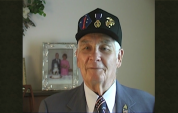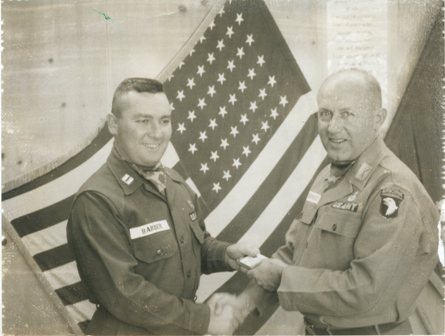7:54 | When Harold Barber saw combat on Guadalcanal, he became very appreciative of his thorough Marine training in firing and movement. He was never really scared but he was hungry and thirsty. When the Army's Americal Division joined the battle, their new M-1 rifles held more bullets per clip and this confused the Japanese who had been up against the Springfield rifle used by the Marines.
Keywords : Harold Barber Guadalcanal rations Japanese Americal Division M-1 M1903 Springfield rifle camouflage John Basilone Medal Of Honor (MOH) water cooled machine gun 37mm gun field of fire

Harold Barber was only fifteen years old when he enlisted in the Marines with the help of his mother. At Parris Island, the dentist deduced that he was not old enough to be there but he didn't blow the whistle. Boot camp was tough but there was a good reason for that.
After a short time on a smaller island, Harold Barber joined the rest of the 1st Marine Division on Guadalcanal. The initial invasion had been largely unopposed but the Japanese were pouring back in and their Navy relentlessly shelled American positions.
The worst thing on Guadalcanal was the stealth of the Japanese fighters. Harold Barber recalls how they could be on top of you before you knew it. They were devious, too, and liked to pretend they were going to surrender.
He was tired but everybody was tired. He was thirsty but everybody was thirsty. He was hungry but everybody was hungry. Harold Barber describes the conditions on Guadalcanal during his time there. He also has something to say about the way war movies present death on the battlefield.
After Guadalcanal, Harold Barber went to Australia for refitting and more training. The next fight was at Cape Gloucester, where he was not on the front line but still faced naval artillery fire and air raids
Harold Barber was lucky during the landing at Cape Gloucester. There was no enemy fire but that didn't last. It was a tough fight and movement was difficult because of the terrain. His friend George White was wounded in the fierce battle for Hill 660. Part 1 of 2.
Near the end of the battle on Cape Gloucester, Chesty Puller organized a patrol to see how far the Japanese had retreated. Harold Barber remembers that patrol and he got a very favorable impression of the fabled Marine commander. Part 2 of 2.
The island of Pavuvu was in a rear area and Harold Barber spent some time there after the battle on Cape Gloucester. He learned how to use a new weapon there, the shoulder fired 60mm mortar. He also learned how to liberate things from the hold on a Navy ship.
At Peleliu, Harold Barber was lucky again during the landing because there was only light fire at that spot. In the interior, the Japanese were well dug in and the fighting was intense. Only 20 out of 220 Marines in his company would walk off the island when it was over.
He didn't even notice that he'd been hit. A piece of shrapnel from a Japanese artillery shell found Harold Barber's leg but he kept right on fighting because of the adrenaline. The Corpsman bandaged him and he was right back in the battle for Peleliu. The Navy was able to stay and take part in the fight unlike when he was on Guadalcanal.
Once the airfield on Peleliu was secured, US aircraft could land and take on fuel and ammunition to take part in the battle for the high ground. Harold Barber recalls that some noncoms were issued shotguns to resist any Banzai charges but the Japanese didn't use that tactic there.
The sergeant said you guys haven't had mess duty in a long time but you're going to have it aboard ship all the way back to the States. According to Harold Barber, it was a blessing in disguise. You mean I get the best food and don't have to stand in line? Great!
The Italian Marines were a breed of their own. Harold Barber describes how they would receive food from home with a surprise inside. He also recalls that age old soldier's tradition, coming up with some alcohol in a war zone.
Harold Barber was baptized three times, twice on his way to battle and then again after he was married. His homecoming from the Pacific was memorable as he was greeted by crowds on the West Coast.

Photos From The Personal Collection of Marine and Ranger Hall of Fame Member Harold Barber. (Caution: Some Graphic Material)